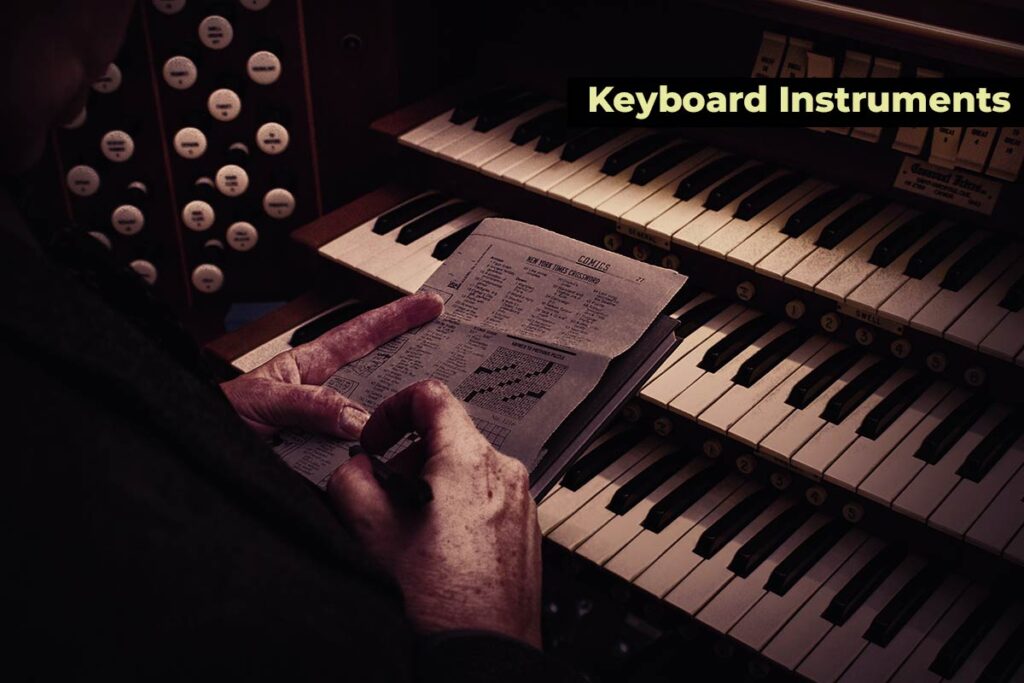A Quick Guide to the Keyboard Instruments

Keyboard Instruments
Keyboard instruments are known for producing different types of notes by simply striking or pressing the keys on the keyboard.
The instrument of this nature had its origins in the early 14th century and they are among the most versatile musical instruments in the world.
In those early days, keyboards were quite basic, with only a few keys, primarily used to play uncomplicated tunes.
As time went on, these keyboard instruments evolved into more sophisticated versions.
Today, we have keyboard instruments with hundreds of keys capable of producing a vast variety of musical sounds.
These instruments can also play multiple notes simultaneously, contributing to the harmonious aspect of the music.
In this article, we will take a closer look at these beloved keyboard instruments.
Specifically, we will learn about their identities, origins, unique features, and their significant influence on the world of music.
What are the Keyboard Instruments?

A keyboard instrument is a musical device that produces various notes through the operation of a keyboard.
Each key on the keyboard, whether they are buttons or part of a lever system, triggers specific sounds when struck or pressed.
They are also a family of musical instruments that produce sound by striking strings or air with hammers or by plucking strings using a keyboard.
This term encompasses a wide range of instruments equipped with a keyboard, including accordions and percussion instruments like the celesta and carillon.
It also includes electronic devices like synthesizers, Moog synthesizers, and digital pianos.
Many of these instruments come with additional features, like pedals for pianos.
These allow players to adjust the sounds they produce, and organs may have stops for similar purposes.
These instruments create sound through a variety of methods. For example, in an organ, air is fanned to produce sound.
Instruments like pianos use vibrating strings that are either hammered or plucked, while synthesizers employ electronic methods.
Additionally, there are other innovative techniques used to generate sound.
Occasionally, instruments like the Glockenspiel, which don’t typically come with a keyboard, may be equipped with one.
Although these instruments lack moving parts and are struck by mallets held by the player, they share a similar layout of keys.
They also generate soundwaves in a comparable fashion.
The keyboard instruments have a rich history, with early versions like the hydraulis dating back to ancient Greece.
Over time, various keyboard instruments evolved, leading to the diverse range we have today.
The significance of this diverse group lies in the keyboard’s ability to allow a musician to play multiple notes simultaneously and in quick succession.
The versatility of keyboard instruments has greatly contributed to their prominence in the world of music.
The History of Keyboard Instruments
The earliest keyboard instrument we know of is the Ancient Greek hydraulis, a kind of pipe organ that was created around the third century BC.
The keys were probably balanced, which means they could be played with a gentle touch.
We can tell this from a mention in a Latin poem by Claudian from the late 4th century.
He wrote, “Let him thunder forth as he presses out mighty roarings with a light touch” (Paneg. Manlio Theodoro).
From the time it was invented up until the fourteenth century, the organ was the main keyboard instrument around.
Organs didn’t always have keys. Some had buttons or big levers that you operated with your whole hand.
Its worth noting that in those early days, almost every keyboard had seven natural notes for each octave.
During the fourteenth century, musical history witnessed the emergence of keyboard instruments like the clavicymbalum, clavichord, and harpsichord, with the clavichord likely predating the others.
The clavichord and harpsichord held their popularity until the piano gained widespread acceptance in the eighteenth century, causing a decline in their usage.
The prototype of the modern piano made its debut in 1698 in Italy, thanks to Bartolomeo Cristofori.
He called it the “gravicèmbalo con piano e forte”, which means “harpsichord with soft and loud.”
This instrument, eventually shortened to the pianoforte, allowed pianists to control the volume by adjusting the force applied to each key.
The piano we know today has evolved considerably since the late nineteenth century.
It possesses a distinct sound and appearance compared to its predecessors, which were familiar to classical musicians such as Mozart.
As the twentieth century unfolded, early electromechanical devices like the Ondes Martenot made their appearance.
These, along with others, paved the way for the electronic keyboards that emerged later in the same century.
Popular Keyboard Instruments
There exist numerous types of keyboard instruments worldwide, spanning various historical eras and contemporary times.
However, only a select few are popular and commonly used in today’s world.
Among the most popular keyboard instruments are the piano, organ, harpsichord, and a range of electronic keyboards such as synthesizers and digital pianos.
In this section of the article, we will explore some of the most popular keyboard instruments.
Specifically, we will provide insights into their historical origins, unique attributes, and significant roles in the realm of music.
Piano
A piano is a large musical instrument that produces sound through a series of strings that are struck by hammers when keys on a keyboard are pressed.
It is a versatile and widely used instrument in various genres of music.
Pianos come in different sizes, with grand pianos being the largest and upright pianos being more compact and space-efficient.
The piano’s keyboard consists of 88 keys, which encompass both white and black keys.
The white keys represent the natural notes (A, B, C, D, E, F, and G), and the black keys represent the sharps and flats (the notes in between the natural notes).
By pressing a key, a mechanism inside the piano causes a hammer to strike the corresponding string, producing the desired pitch.
Pianos are known for their dynamic range, allowing for a wide range of expression in music, from soft and delicate to powerful and resonant.
They are used in a variety of musical styles, including classical, jazz, pop, and many others.
The instrument holds a central place in the world of music and is often used for solo performance, accompaniment, and composition.
Organ or Pipe Organ
A pipe organ is a large and complex keyboard musical instrument known for its majestic and powerful sound.
It operates on a system of wind-blown pipes, each producing a distinct pitch.
The organ is composed of multiple ranks of pipes, which are organized by timbre and pitch, and they are controlled by a keyboard.
When a musician presses a key on the organ’s keyboard, it opens a valve, allowing air to flow through a pipe and producing sound.
The pipes can vary greatly in size, from small, flute-like pipes to large, resonant ones.
This diversity of pipes allows the organ to generate a wide range of tones and dynamics.
In addition to the keyboard, a pipe organ often includes pedals, which are played with the feet.
This expands the instrument’s range and allows for even greater complexity in musical arrangements.
Pipe organs are commonly found in churches, cathedrals, and concert halls due to their ability to fill large spaces with rich, harmonious music.
They are also highly valued in classical and sacred music traditions.
The intricate design and craftsmanship involved in creating and maintaining a pipe organ contribute to its reputation as one of the most complex and awe-inspiring musical instruments in the world.
Harpsichord
A harpsichord is a historical keyboard instrument. It was particularly popular during the Baroque period of music, roughly spanning from the 17th to the mid-18th century.
It produces sound by plucking strings with quills or leather plectra (small, thin pieces) when keys on the keyboard are pressed.
Unlike a piano, which uses hammers to strike the strings, the harpsichord’s plucking mechanism creates a distinct, clear tone.
Harpsichords come in various sizes and styles, with differences in the number of keyboards (manuals) and the number of strings per note.
Harpsichords come in various configurations. Some have a single manual, while others may feature two or even more, allowing for a broader range of musical expression.
The instrument’s sound can range from delicate and crystalline to bold and resonant. This versatility made it suitable for various musical styles of the Baroque era.
The harpsichord, while less frequently employed in contemporary music, continues to hold historical and artistic importance.
Its distinctive timbre and contribution to the musical heritage of its era are widely acknowledged and valued.
Accordion
An accordion is a keyboard musical instrument that belongs to the free-reed family.
It consists of a portable box-shaped body with a set of reed chambers.
The instrument is equipped with a keyboard and a series of buttons or keys that, when pressed, open valves to allow air to flow over reeds, producing musical tones.
Accordions are known for their versatility and are capable of producing a wide range of musical sounds.
They come in various sizes and configurations, including diatonic and chromatic models.
Diatonic accordions are commonly used in folk and traditional music, while chromatic accordions are favored in a broader range of musical genres.
The accordion is played by compressing and expanding the bellows while manipulating the keys or buttons to create melodies and harmonies.
It is a popular instrument in many musical traditions worldwide, known for its expressive capabilities and distinctive sound.
Celesta (or Celeste)
The celesta, often referred to simply as a celeste, is a musical instrument that belongs to the percussion and keyboard families.
It resembles a small upright piano and produces sound through a set of metal bars struck by hammers when keys on a keyboard are pressed.
These bars are made of steel and are arranged in a keyboard layout similar to that of a piano.
The celesta creates a delicate and bell-like sound, which gives it a distinctive and ethereal quality.
It is often used to add a touch of enchantment or sparkle to orchestral compositions.
The instrument’s gentle timbre makes it particularly suitable for creating magical and whimsical atmospheres in music.
The celesta, known for its distinctive sound, has been prominently featured in both classical compositions and film scores. It adds a unique and recognizable sonic character to a wide range of musical pieces.
Its charming and otherworldly tones have made it a valued addition to orchestral and ensemble settings.
Electric Keyboard/Synthesizer
An electric keyboard, commonly known as a synthesizer or synth, is a musical instrument that generates sound electronically.
It differs from traditional acoustic instruments like pianos or organs, as it doesn’t rely on strings or pipes.
Instead, it produces sound by manipulating electrical signals through various electronic components.
Synthesizers allow musicians to create a wide range of sounds. These include imitations of traditional instruments as well as entirely unique and experimental tones.
In synthesizers, sound generation is accomplished through the use of oscillators, which produce sound waves. Filters then shape the frequency response, and modulators control various aspects of the sound.
This sophisticated interplay of components allows for precise control over pitch, tone, and various other parameters in electronic music production.
Electric keyboards and synthesizers are popular in a diverse array of musical genres, including electronic, pop, rock, and experimental music.
They are valued for their versatility, enabling musicians to explore and innovate with sound in ways that would be impossible with acoustic instruments alone.
Keyboard Instruments and Their Repertoire
Keyboard music encompasses a broad range of instruments, namely the harpsichord, piano, organ, and others.
Each of these falls into a distinct family of related instruments, yet there’s notable overlap in the repertoire they share.
For instance, music composed for the harpsichord found its way onto various instruments like clavichords, spinets, and virginals.
Similarly, during the latter part of the 18th century, piano music closely resembled that written for the harpsichord.
Organ music encompasses a wide array of instruments, including positives, harmoniums, and electronic devices. These are all designed to mimic the grandeur of a pipe organ.
In the earlier period, before 1700, there was a significant convergence between music meant for the harpsichord and the organ.
However, certain national schools, particularly the French, began to cultivate distinct styles for these two instruments as early as the 17th century.
Despite the clavichord’s unique method of producing sound, it seldom developed an exclusive repertoire.
During the evolution of keyboard music, a significant portion of the repertoire comprised arrangements or transcriptions of pieces initially composed for vocals or other instruments.
This demonstrates the adaptability and versatility of keyboard instruments in interpreting various musical compositions.
Additionally, there exists a modest yet noteworthy body of work intended for more than one player at a keyboard or for multiple keyboard instruments.
Music that combines keyboards with other instruments or voices can be categorized into chamber music. It can also be classified as orchestral music, or music for voices or melody instruments.
Terms Used for Keyboard Instruments
There can be some confusion when it comes to the terminology used for certain keyboard instruments, which in turn can affect the categorization of the music itself.
For instance, in England during the Elizabethan era, the term ‘virginal’ was used to refer broadly to what we now call a ‘harpsichord.’
Similarly, in France, ‘spinet’ or ‘épinette’ was the preferred term for harpsichord until the late 17th century. Then, ‘clavecin’ took over as the generic term.
In Germany, the term ‘keyboard’ (clavier or klavier) came to represent the ‘piano’ by the end of the 18th century, excluding the organ.
In fact, some modern authors writing in English chose to distinguish between “keyboard music” and “organ music”. They even used ‘clavier’ as an English term that specifically excludes the organ.
Lastly, in the early history of the piano, the terms ‘pianoforte’ and ‘fortepiano’ were used interchangeably.
However, a convention has emerged in modern times to reserve ‘fortepiano’ for instruments built in the style of those constructed before the second third of the 19th century.
Final Note
Keyboard instruments have played an integral role in the world of music for centuries.
From the classical grandeur of the piano to the innovative electronic synthesizer, each instrument brings its own unique character to the musical landscape.
They continue to be fundamental tools for composers, performers, and music enthusiasts around the world.
We hope this article has introduced you to various types of keyboard instruments, specifically some popular ones.
Of course, there are other historical keyboard instruments that are seldom encountered in today’s world.
But with the knowledge gained, you can now embark on a journey to explore even more of them.
You can also go ahead and learn how to play some of these instruments.
Generally, playing a keyboard instrument requires diligent training due to its diverse technical features.
Nevertheless, having a solid grasp of music fundamentals and the piano will provide an excellent starting point for playing each of these instruments.
At Phamox Music, we go all out for exactness and honesty. For this purpose, if by any means you found any possible glitch, be it factual, editorial, or something that we need to update, kindly contact us.
If you find the information provided in this post “Keyboard Instruments” interesting and helpful, kindly share it with someone you know that might need it.








This is the right website for anybody who wants to find out about this topic.
You realize so much its almost tough to argue with you (not that I personally will need to…HaHa).
You definitely put a new spin on a topic that has been written about for a long time.
Great stuff, just excellent!